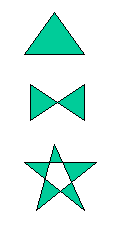
Kobon triangle problem
Encyclopedia

Saburo Tamura proved that the largest integer not exceeding k(k − 2)/3 provides an upper bound on the maximal number of nonoverlapping triangles realizable by k lines. In 2007, a tighter upper bound was found by Johannes Bader and Gilles Clément, by proving that Tamura's upper bound couldn't be reached for any k congruent to 0 or 2 (mod 6). The maximum number of triangles is therefore one less than Tamura's bound in these cases. Perfect solutions (Kobon triangle solutions yielding the maximum number of triangles) are known for k = 3, 4, 5, 6, 7, 8, 9, 13, 15 and 17. For other k-values the Kobon triangle solution numbers are not known. For k = 10, 11 and 12, the best solutions known reach a number of triangles one less than the upper bound.
| k | 3 | 4 | 5 | 6 | 7 | 8 | 9 | 10 | 11 | 12 | 13 | 14 | 15 | 16 | 17 | 18 | 19 | 20 | 21 | OEIS |
| Tamura's upper bound on N(k) | 1 | 2 | 5 | 8 | 11 | 16 | 21 | 26 | 33 | 40 | 47 | 56 | 65 | 74 | 85 | 96 | 107 | 120 | 133 | |
| Clément and Bader's upper bound | 1 | 2 | 5 | 7 | 11 | 15 | 21 | 26 | 33 | 39 | 47 | 55 | 65 | 74 | 85 | 95 | 107 | 119 | 133 | - |
| best known solution | 1 | 2 | 5 | 7 | 11 | 15 | 21 | 25 | 32 | 38 | 47 | 53 | 65 | 72 | 85 | 93 | 104 | 115 | 130 |
External link
- Johannes Bader, "Kobon Triangles"

